For the past year, I’ve been reporting on how “forever chemicals,” a group of toxic contaminants known as PFAS, can end up in our sewage and farmland.
It’s not well known, but when wastewater treatment plants treat our sewage or wastewater, there’s a thick sludge that’s left behind. And much of that sludge is used as fertilizer on farms across the country.
In my latest article, I looked at how a lack of action at the federal level, and a hodgepodge of state regulations, can mean some states risk becoming the dumping grounds for contaminated sludge. As a result, some of these communities are pushing back.
You could call it a form of NIMBY-ism. Every state produces sewage sludge, and it needs to go somewhere. And reusing sewage sludge as fertilizer has its benefits. It is rich in nutrients. And spreading it on fields cuts down on the need to incinerate it or put it in landfills, which would have other environmental costs. Using sludge fertilizer also reduces the use of synthetic fertilizers that are based on fossil fuels.
But when PFAS turns up in sludge used as fertilizer, it can become a problem. PFAS, or per- and polyfluoroalkyl substances, have been linked to developmental delays in children, reproductive health harms, cancer and other illnesses.
The federal government regulates some pathogens and heavy metals in sludge used as fertilizer, which is also known biosolids, but not PFAS. That has left states, and some communities, to handle the issue on their own.
How to learn more
So, what’s happening in your state or community?
For starters, you can look up what your state has done to address the issue. Maine has banned the use of sewage sludge on farmland altogether. Connecticut has banned the use of sludge that contain PFAS.
Maryland has ordered up testing at its wastewater treatment plants, and adopted guidelines for biosolids that can be used at farms. New Hampshire, Massachusetts, Colorado, Michigan, Minnesota, New York and Wisconsin have also adopted some restrictions.
Some wastewater treatment plants are starting to disclose whether they’ve found PFAS in their wastewater or biosolids. You can figure out which treatment facility handles wastewater from your neighborhood. (If you live in a large metropolitan area, start with the local municipal water utility.)
Reach out to ask whether they’re testing for PFAS, and ask to see the testing results. Interpreting what you get back can be tricky, and regulatory agencies are still trying to figure out what safe PFAS thresholds might be.
In its first-ever risk assessment of PFAS in biosolids, the Environmental Protection Agency said that levels of two kinds of PFAS exceeding 1 part per billion could lead to health risks. But Maryland only recommends that biosolids not be used on farmland if PFAS levels exceed 100 parts per billion. Ask your water treatment plant how they interpret their testing results.
You could also go a step further and ask your local wastewater facility what they’re doing to prevent PFAS from entering their operations. Advocacy groups like the Southern Environmental Law Center have been pushing treatment plants to require that factories and other industrial facilities clean any wastewater they discharge of PFAS.
Kathleen Sullivan, a spokeswoman at the law center, told me that in one case a manufacturer pressed by a wastewater treatment plant decided to stop using PFAS altogether.
Finding out where sludge ends up
In most states, farmers need to get a permit to use biosolids and indicate on which fields they’ll use the fertilizer. But states don’t readily disclose the information in those permits, so it can be tricky to find out where sewage sludge is going in your community.
One exception is Maine, the only state to have banned sewage sludge use. Maine maintains an interactive map of known locations where sludge fertilizer has been used, as well as the results of state water and soil PFAS tests.
Some news outlets have used permit data to map out where sewage sludge has been historically applied. The State, a South Carolina newspaper, did that as part of an in-depth investigation into PFAS contamination of biosolids used by local farmers.
Finally, what about concerns over food?
The E.P.A.’s risk assessment suggested the general food supply was unlikely to be at risk. (Most people eat food from so many different sources that it’s unlikely they’ll eat a dangerous amount of PFAS from one contaminated source.)
But for households that rely on, say milk or beef from a family farm contaminated with PFAS from sewage sludge, the risks could be higher, the agency warned. Last year, I reported on a New Hampshire family that grappled with those concerns.
Climate science
Across America, big cities are sinking. Here’s why.
A new analysis of America’s 28 largest population centers found that all but three are sinking overall, and in many cases significantly. Several of the most affected areas are in Texas, particularly around Fort Worth and Houston. But the problem is nationwide, affecting cities as scattered as Seattle, Detroit and Charlotte, N.C.
The sinking of land, also called subsidence, can worsen the effects of sea level rise, intensify flooding and strain the very foundations of urban infrastructure.
The new research, published in the scientific journal Nature Cities, built on previous work using satellite measurements to paint a detailed picture of rising and falling land. It also closely examined the connection between changes in land elevation and changes in groundwater, using data from individual monitoring wells. — Mira Rojanasakul
Read more.
Related: A 2023 New York Times investigation found that unsustainable pumping of water from aquifers can be a major cause of sinking land.
By the numbers
More than $500 billion
The Environmental Protection Agency plans to eliminate Energy Star, the popular energy efficiency certification for dishwashers, refrigerators, dryers and other home appliances, according to agency documents and a recording of an internal meeting.
Since its creation in 1992, the Energy Star program has helped households and businesses save more than $500 billion in energy costs and to get rebates and tax credits, according to the program’s 2024 report. Nearly 90 percent of American consumers recognize the Energy Star label, according to the government. — Lisa Friedman and Rebecca F. Elliott
Read more.
Climate Politics
Why 35 House Democrats joined Republicans in voting against a major climate policy
Last week, 35 Democrats voted to help Republicans repeal California’s landmark requirement that all new vehicles sold in the state be electric or otherwise nonpolluting by 2035.
The 246-to-164 vote in the House stunned environmentalists, who said they were struggling to understand why nearly three dozen Democrats voted to kill one of the most ambitious climate policies in the country. For the past few years, Democrats have overwhelmingly voted for stronger policies to tackle global warming.
Some wonder whether that unity is starting to fray in the face of intense lobbying and worries about rising prices amid Trump’s trade wars. — Lisa Friedman
Read more.
More climate news from around the web:
-
More than half of children born in 2020, or roughly 62 million people, will experience “unprecedented lifetime exposure” to heat waves, according to a new study highlighted by Carbon Brief.
-
Orstead, a Danish company, has canceled plans to build the Hornsea 4 wind power project off the coast of Britain, Reuters reports. It would have been one of the world’s largest offshore wind farms.
-
Heatmap News examines a Republican plan to overhaul the National Environmental Policy Act, one of the country’s key laws governing permits for development projects.
Thanks for being a subscriber.
Read past editions of the newsletter here.
If you’re enjoying what you’re reading, please consider recommending it to others. They can sign up here. Browse all of our subscriber-only newsletters here. And follow The New York Times on Instagram, Threads, Facebook and TikTok at @nytimes.
Reach us at [email protected]. We read every message, and reply to many!


















